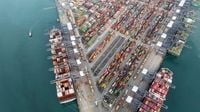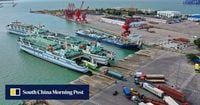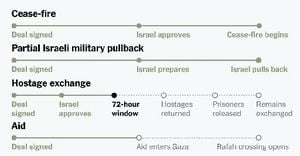On October 10, 2025, China announced a sweeping new set of port fees targeting U.S.-linked vessels, a move that marks a sharp escalation in the ongoing maritime and trade dispute between the world’s two largest economies. The new fees, which will take effect on October 14, are widely viewed as direct retaliation for the U.S. government’s own planned port charges on Chinese ships—set to begin the very same day. As both sides dig in, the global shipping industry finds itself caught in the crossfire, with analysts warning of ripple effects that could disrupt trade, raise costs, and further strain already tense relations.
According to AP and Reuters, China’s Ministry of Transport declared that vessels owned, operated, built, or flagged by American companies or individuals will now face a hefty 400 yuan ($56) per net ton fee each time they dock at a Chinese port. The fee applies for up to five voyages per ship per year and is set to climb annually, reaching a steep 1,120 yuan ($157) per net ton by April 2028. The ministry emphasized that these special fees are “countermeasures” in response to what it called the “wrongful” and “discriminatory” U.S. practices. In a statement, the ministry said the American fees “severely damage the legitimate interests of China’s shipping industry” and “seriously undermine” the international economic and trade order.
Beijing’s move mirrors Washington’s own plans: starting October 14, the U.S. will charge Chinese-owned or -operated ships $50 per net ton for each voyage to an American port, with the fee rising by $30 per net ton each year until 2028. Like China’s policy, the U.S. measure caps charges at five voyages per vessel per year. The tit-for-tat nature of these rules has not gone unnoticed by industry observers. “This is just more tit-for-tat negotiating tactics. The U.S. placed similar fees on China-bound vessels and now China is doing the same,” Peter Alexander, managing director of Z-Ben Advisors in Shanghai, told CNBC. He added, “China can give as good as it gets and has demonstrated a willingness to take direct action.”
The scope of China’s new fees is broad. Not only do they hit ships with obvious U.S. connections—such as those built in the U.S., flying the American flag, or directly owned by U.S. companies—but they also ensnare vessels with 25% or more ownership or board seats held by U.S.-domiciled investment funds. According to Erik Broekhuizen, a marine research manager at ship broker Poten & Partners, “This casts a wide net and could affect many public shipping companies with a listing on U.S. stock exchanges.” The result? “The potential impact is significant.”
Indeed, the new rules are expected to impact a surprising number of vessels. Analysts cited by Reuters estimate that nearly 10% of the world’s very large crude carrier fleet, and 13% of the Suezmax, Afra, and LR2 fleets could be subject to China’s port fees. Samantha Hartke, head of Americas analysis for the energy research firm Vortexa, told Reuters that 43 liquefied petroleum gas-carrying super tankers—about 10% of the global fleet—will be affected. Even oil tanker operators, who are mostly based outside the U.S., may find themselves caught up in the new rules if their companies are listed in the United States.
The financial stakes are high. A recent report from shipping data provider Alphaliner, cited by AP, warned that the U.S. port fees could cost the world’s top 10 carriers up to $3.2 billion in 2026 alone. China’s fees, which scale steeply with ship size, could inflict similar pain on U.S.-linked shippers. Kun Cao, deputy chief executive at consulting firm Reddal, noted, “It explicitly targets any ship with meaningful U.S. links—ownership, operation, flag, or build—and scales steeply with ship size.” While North America accounts for roughly 5% of the world fleet by beneficial ownership, the U.S. has only about 0.1% of global commercial shipbuilding market share, according to the Center for Strategic and International Studies. In stark contrast, China boasts 53.3% of global shipbuilding capacity, underscoring the lopsided nature of the industry.
The timing of these retaliatory measures is no accident. They come just weeks before President Donald Trump and Chinese leader Xi Jinping are expected to meet on the sidelines of the Asia-Pacific Economic Cooperation forum in South Korea. The backdrop is one of mounting friction: China has recently imposed new export restrictions on rare earths, lithium battery technology, and even expanded its “unreliable entities” blacklist to include U.S.-linked chip consulting firms. Meanwhile, President Trump on October 10 announced a dramatic escalation of tariffs on Chinese exports to the U.S., raising them to 100%, and imposed export controls on critical software in response to China’s curbs on rare earth minerals.
For shippers and exporters, these dueling fees add another layer of complexity—and cost—to global trade networks already under pressure. Joe Kramek, president and CEO of the World Shipping Association, told Reuters, “The fees announced by China, like those put in place by the U.S., add further complexity and cost to the global network that keeps goods moving and economies connected, and risk harming their exporters, producers, and consumers at a time when global trade is already under pressure.”
Industry insiders warn the impact will be felt in several ways. In the short term, Michael Hart, president of the American Chamber of Commerce in China, told CNBC, “This will result in an increase in costs for U.S. consumers, a decrease in profits for shippers, and a small decline in demand for exports to the U.S. in certain categories.” Over the longer term, Hart predicts more demand for non-Chinese ships, though he doesn’t expect a surge in orders for U.S.-made vessels given their high costs and limited shipbuilding capacity.
The policy’s complexity is evident in how it will be enforced. Both countries’ fees apply to a vessel’s first five voyages per year, and both target ships with broad links to the opposing nation. Some vessels, such as those owned by international shipping giants but with significant U.S. or Chinese investment, could end up paying both sets of fees. The result, as Lars Jensen, CEO of Vespucci Maritime, pointed out on LinkedIn, is a tangle of compliance headaches for companies like Maersk Line Limited, American President Lines, and Zim—some of which are already notifying customers that they have no plans to change service schedules despite the new costs.
As U.S.-China trade tensions deepen—particularly after a 90-day tariff truce that began in August and is set to expire in November—there is little sign of de-escalation. The Chinese Ministry of Transport maintains its stance that the U.S. fees are “clearly discriminatory and severely damages the legitimate interests of China’s shipping industry, seriously disrupts the stability of the global supply chain, and seriously undermines the international economic and trade order.”
With both sides now locked in a cycle of escalation, the shipping industry—and by extension, consumers and businesses worldwide—are left to navigate an increasingly fraught and expensive seascape. The next few weeks, as leaders meet and new policies take effect, will be crucial in determining whether this standoff deepens or a path to compromise emerges.





